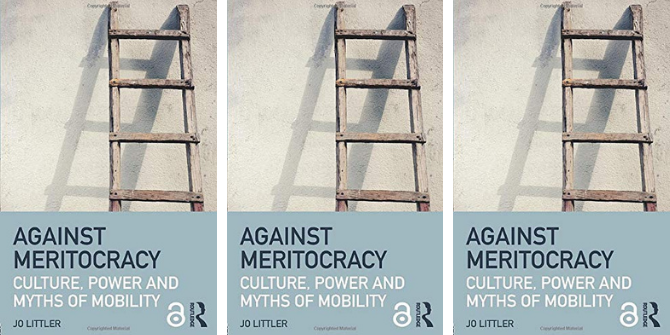In Social Mobility and its Enemies, Lee Elliot Major and Stephen Machin offer a thought-provoking assessment of the state of social mobility in Britain. In the context of much social and political change and rising levels of inequality in Britain, this book is able to dispel the myth of meritocracy and suggest evidence-informed avenues for achieving a fairer society for all, writes Ross Goldstone.
If you are interested in this book review, you can listen to a podcast recording of Lee Elliot Major and Stephen Machin in conversation with Sanchia Berg as part of the LSE event ‘Tackling Britain’s Social Mobility Problem’, recorded on Thursday 7 November 2019.
Social Mobility and its Enemies. Lee Elliot Major and Stephen Machin. Pelican. 2018.
Have you ever wondered why those at the top tend to come from the same backgrounds? Or how severe the social mobility crisis in Britain really is—and what has, and continues to, cause it? If so, then Lee Elliot Major and Stephen Machin’s recent contribution to the Pelican Books series, Social Mobility and its Enemies, is a must-read.
Through critically engaging with rigorous and reputable research in this area, the book provides a thought-provoking assessment of the state of social mobility in Britain. In so doing, the authors spell out what might be done to reverse the trend of low social mobility which has accelerated over decades, so that a fairer society, with opportunities for all to achieve social mobility, can be created. The book comes at a time of growing economic and social inequality in Britain that has ushered in a social mobility crisis and thus holds contemporary policy relevance. Considering the part played by stagnant opportunities for significant proportions of the population in current political events, such as the UK EU referendum result (71), also enables the book to contribute to existing debates over how to move forward in post-Brexit Britain.
Social mobility ‘tells us how likely we are to climb up (or fall down) the economic or social ladder of life’ (4). The ‘enemies’ referred to in the book’s title are those privileged social elites who are able to hoard opportunities to prevent sliding down the social ladder, and in so doing, limit opportunities for social mobility for those at the bottom (195). However, the measurement of this complex social phenomena is not straightforward, with the measures, variables and forms of social mobility used (such as absolute or relative) being influential on findings produced on the topic. For example, it may be possible to discover increased absolute social mobility, but stagnant relative mobility (16). What Major and Machin are able to do in this book is provide an accessible and evidence-based account of complex statistics on the social mobility problem in Britain; the mechanisms underpinning this, including the key role education plays in hindering, as much as enabling, social mobility; and the consequences of low social mobility for British society, be these economic, social or political. This review focuses on the authors’ discussion of the two latter areas: firstly, the implications of immobility in contemporary Britain; and secondly, the contentious relationship between education and social immobility.
Throughout the book, there are telling indications of the importance of social mobility both economically and socially. Major and Machin demonstrate throughout Part One that the UK has one of the highest levels of inequality and the lowest levels of intergenerational mobility (see Figures 1.3 and 3.6) amongst a range of developed nations. Whilst there are political and economic differences between many of these and the UK, similar Anglophone countries perform better: ‘Australia and Canada have lower betas [levels of intergenerational immobility] and more income mobility than Britain’ (25-31). Thus, this suggests that ‘Britain is less mobile than it could be’ (29). This trend is not reversing: instead ‘income mobility [has] declined across recent generations’ (26). Partly, this has taken place during a time when the gap between rich and poor in the UK has increased, largely as a consequence of property-based wealth, because ‘in developed economies, housing wealth is the largest component of […] overall wealth’ (39).
This immobility is, for Major and Machin, damaging for British society economically (127), socially (Chapter Five) and politically (73). Economically, the price of immobility is estimated at ‘an annual increase in the country’s GDP of between 2 and 4 per cent’ (57). Furthermore, enhancing social mobility is believed to be an important element of solving Britain’s productivity problem. This is because in ‘more mobile societies jobs are filled by those with the highest level of potential to perform well in that role, rather than someone who may be less well suited but better connected’ (57). But there are social and political implications to not enabling everyone an equal opportunity to achieve social mobility. The authors illustrate how immobility in Britain can be understood as a factor in the result of the EU referendum. Figures 3.2 and 3.3 demonstrate ‘a strong link between areas of low mobility and [… voting] to leave the European Union’ (73). What this suggests is that immobility breeds discontent and disaffection, enabling those with objectives of social change to capitalise on the frustrations of the immobile. A similar story can be said of the election of Donald Trump as president of the United States.
The role of education in social (im)mobility is a contentious one. For those in policy circles buying into notions of human capital theory, education is the ‘great social leveller’ (87). While education is vital for social mobility, the role education plays in mobility is complicated. Major and Machin problematise this relationship by discussing what they call ‘education’s dark side’ (83). Their particular focus is on ‘the extra investments made by middle-class families to enable their children to get ahead during the early years’ (95) as well as ‘Britain’s Privately Educated Elites’ (129), who are able to monopolise the most advantageous educational opportunities and lucrative labour market destinations. In an increasingly knowledge-based, globalised economy, where education is a basic requirement for most skilled work, it is the poorest that are least capable of capitalising on this, even when they attain highly. For those that consecutive governments have failed, lacking basic skills, the prospects of mobility are bleak. Major and Machin starkly conclude that the ‘education system remains tilted in countless ways to the already advantaged’ (112). It is for this reason that education reform is key to their proposals for change. Ideas are provided in Part Three, including a rethinking of education beyond the academic (183) and education system reform, focusing specifically on access to ‘good’ educational opportunities (206). However, education is not the sole driver of change for Major and Machin, as a restructuring of the labour market and work remuneration are also recommended.
However, one limitation of this book is the lack of consideration of the ‘costs’ of social mobility. There is increasing recognition that social mobility is far from a straightforward process of smoothly ascending the social hierarchy as depicted in policy texts. Despite this, the book does not critically explore the notion of social mobility and whether contemporary ideas as to whether those not from privileged backgrounds can achieve this are outdated. The strong policy focus of the book would enable such a problematisation of social mobility to be pushed into current debates and for a more fruitful understanding of the troubles of traversing the social ladder to be at the heart of these.
Irrespective of this omission, Major and Machin offer a timely contribution to debates surrounding social mobility. The book joins other recent publications that have considered notions of social mobility, in addition to those critically exploring education in contemporary society in terms of equality, opportunity and mobility. These include Miseducation by Diane Reay, The Class Ceiling by Sam Friedman and Daniel Laurison and Engines of Privilege by Francis Green and David Kynaston. Given the authors are from academic and policy-focused backgrounds, the book will appeal to academics across the social and policy sciences interested in issues surrounding social mobility, inequality and education, as well as those from outside of the academy interested in creating a fairer society. In the context of much social and political change and rising levels of inequality in Britain, this book is able to dispel the myth of meritocracy and suggest evidence-informed avenues for achieving a fairer society for all.
Note: This review gives the views of the author, and not the position of the LSE Review of Books blog, or of the London School of Economics.
Image Credit: (Pixabay CC0)


 Find this book:
Find this book: 





